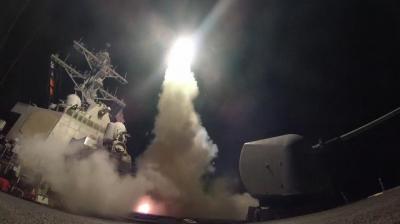‘One-off actions’, such as the American attack in Syria, carry a risk: there is no turning back without loss of face.
After the US cruise missile attack on Syria’s Al-Shayrat military base, the critical question is: was this a one-off warning from a continued volatile and unpredictable Trump, or does the punishment action following the poison gas attack on Khan Shaykhun mark the start of a real US policy on Syria?
Let us start with the first scenario: this explanation is based on an understandable emotional eruption on the part of the President, who presses a red button when he sees “two beautiful” dead babies in the arms of an inconsolable father. But that is not a sufficient explanation. After all, why would the President react in that way to a nerve gas attack, but not to the previous countless horrific attacks with cluster bombs and chlorine gas, even on schools and hospitals?
Doing nothing was not an option; he had to mark himself out from his “terrible” predecessor Obama. And he justified that by speaking this time of “many, many red lines” that Assad had crossed, as if Obama’s single red line dating back to 2012 - any future use of poison gas - was not sufficient. But the reviled Obama had got Syria to join the Chemical Weapons Convention (CWC) in 2014. It is also notable that Trump used the “vital national security interest” as an argument to fire the Tomahawks. In other words, not maintaining international peace and security or another supranational standard, as if it was a kind of self-defence; thus immediately downplaying the humanitarian aspect. So here too there were echoes of America First, even if it is not clear precisely which American security interest was at stake.
The notion that the cruise missile salvo was a “one-off” signal was also immediately corrected by Nikki Haley, the US ambassador to the United Nations. She swore on Saturday that the action would be repeated if Assad had the audacity to bring out more poison gas. Therein lies the risk of the action: there is no turning back without loss of face. In future it will be impossible to stand idly by in the event of any fresh provocation by Assad – chlorine gas, nerve gas, barrel bombs, refusal to cooperate with inspections by the Organisation for the Prohibition of Chemical Weapons (OPCW).
Quite a few ‘one-off’ punitive actions in the past have become unintentionally extended. Examples include Operation Desert Fox in 1998, when President Bill Clinton unleashed more than 400 cruise missiles against Saddam Hussein due to his obstruction of weapons inspections. What started as a four-day campaign actually lasted three years. The conclusion is that as a one-off signal from Trump, well-intentioned but with no guarantee of success, 7 April was a day of brief self-gratification, not of solution.
So did the punitive attack on Al-Shayrat indicate a well-considered change of US policy? It could be argued that this was the intention, to stop Assad making further use of chemical weapons. In geopolitical crises, of course, you have to fathom the deep reality behind all the public hullabaloo. But it can be deduced from various facts that the US was not looking to demonstrate a drastic policy overhaul, at any rate no shift to an interventionist policy.
The Americans went for the most conservative military option (not attacking runways, only hangers and storage depots). They eschewed the military alternative – equipping the Syrian rebels with anti-aircraft missiles that they could use to down Syrian and Russian planes; that would have entailed a risk that Russian pilots might die, or that such weapons might fall into the wrong hands. The US has given the Russians a timely warning and not attacked any ‘Russian’ airbases in Syria operating Russian anti-aircraft systems. Some commentators see the fact that Putin ordered no deployment of Russian anti-aircraft artillery against the cruise missiles as a sign that the Russians too wanted to see it as an incident.
On Sunday afternoon, Syria, Russia and Iran said that they would retaliate in the event of further US attacks; that was possibly a shrewd negotiating move: the 7 April attack would not trigger retaliation, but any follow-up attacks might. US Secretary of State Tillerson, due to visit Moscow next week, can prepare for the worst.
But this explanation is also inadequate. The US – but, significantly, not yet Trump himself! – has said that regime change (Assad must go) is indeed once again a US priority. The conclusion must therefore be that there is no fully-fledged policy behind the cruise missile attack. It has rapidly evolved from a one-off warning signal to a repeatable threat. It has been reformulated in various terms by the US government and enshrined by Trump himself in the mantra ‘I’m not saying anything about my next steps, because unpredictability is my major asset’. But the result is that events determine the policy; the policy does not determine the events. And that was not the intention.
This opinion is published in Dutch in NRC Handelsblad.





